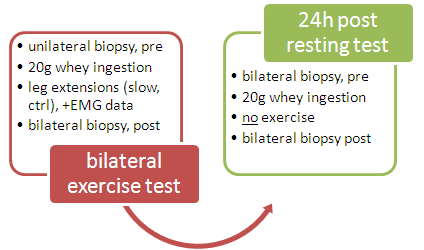Time Under Tension (TUT) Another Under-Appreciated Determinant of the Protein Synthetic Response to Exercise?
 |
| Image 1: Is it really time to buy some revolutionary new exercise equipment to time your time under tension? Or should you keep pumping away like there was no tomorrow? |
Wait! Is protein synthesis really that important?
I will probably touch on this issue in tomorrow's installment of the Intermittent Thoughts, as well, so let me just say this: Muscle protein synthesis is only one out of two (maybe three processes) and probably not even the most important one, when your goals are getting really big or really strong. I mean, if increasing protein synthesis was all it would take to get as buffed as Phil Heath and as strong as Derek Poundstone, everyone would be training like a sissy (like in this study), take his BCAAs and whey protein and see amazing results... but I am once again getting off a tangent here, and as I already said, you will read more on that here at the SuppVersity in the future. So, for the time being, let's get back to the time under tension, i.e. the exact number of seconds your muscles are actually working (meaning contracting) during a given set.
 |
| Figure 1: Basic outline of the study first and second testing session (based on Burd. 2011) |
Participants subsequently performed bouts of unilateral leg extension exercise at 30% ofThe participants performed a total of 3 sets with 2 minutes of rest between the sets for each condition. Lifting cadence was monitored by an instructor and by the use of a metronome. Moreover, the exact knee-joint angles were recorded by the means of a goniometer. After a subsequent 2nd blood sample was taken, all participants consumed 20g of whey protein isolate. 6h after, a 2nd bilateral biopsy was taken and the participants were fed a standard cafeteria meal. For the rest of the day they were advised to follow a diet that would mirror their previously recorded food intake, with the last meal being consumed before 22h, "to ensure a 10 h fast prior to the beginning of the 24 h post-exercise protein synthesis measurement", which took place the next morning after the consumption of another 20g of a tracer-enriched whey protein supplement.
their previously established concentric 1RM. Legs were randomized and balanced for dominance based on maximal strength to perform exercise at a slow lifting (SLOW) or an external work-matched control (CTL) conditions. The leg assigned to the SLOW condition performed exercise with a lifting/lowering cadence of 6 s concentric phase and a 6 s eccentric phase with no pauses until volitional fatigue (i.e. failure). Failure was defined as the point at which the participant could not lift through the full range or their technique to lift the load included motions at joints other than the knee. The CTL condition was completed with the contralateral leg and was matched to the experimental condition for contraction volume such that the leg performed an identical number of repetitions at an equivalent load, but not to failure, and was performed with a lifting cadence of 1 s concentric phase and a 1 s eccentric phase.
 |
| Figure 2: Fractional protein synthesis (in % per hour) - left; and relative differences in protein synthesis of slow vs. ctrl condition - right (based on Burd. 2011) |
[w]hat we observed here was a potentiated effect, from that seen in the fasted-state, of prior exercise in enhancing the feeding-induced myofibrillar protein synthetic rates. This effect appears to be dependent on maximal fibre activation during exercise, [...] The current study is noteworthy in that an enhanced effect of protein feeding during late exercise recovery was induced by a longer time under muscle tension rather than intensity-independent contraction volume, which we have previously examined (Burd. 2010).As far as the delay in the normally immediate increase in myofibrillar protein synthesis is concerned, the researchers speculate that both the timing of the biopsies, as well as the training status of the subjects and the specificity of their protocol about which they state that with its long loading times at relatively low intensities it must have shifted the protein (immediate) myofibrillar protein synthetic response "toward increased synthesis of proteins in the mitochondrial and sarcoplasmic pools" (cf. figure 2) - a process the underlying causes and mechanisms of which are yet unclear.
Why would you change a winning team?
This is particularly true if we take into account the results of another pretty recent study be Eonho Kim et al. (Kim. 2011), which found that an even slower (10s concentric, 10s eccentric) training protocol at 50% or the 1RM led to greater increases in flexibility but highly variable and overall lower strength gains than a traditional protocol with (4s total TUT at 80%RM) in college-aged women. This basically confirms what previous studies by Keeler et al. (+39% in traditional, only +15% in slow training; Keeler. 2001) have already established: (Super) Slow Training works, but it does not work as well classic resistance training.
And no matter whether you train slow or fast - in the end, intensity will always be determined by a matrix of loads, volume, TUT and training density and I doubt we will see a study that controls for all this variables even in the remote future (and if that happens you know that the SuppVersity is the place where you will read about it, first) - so the best thing you can do, is to rely on what worked for generations of physical culturists and that was definitely not training with 6s concentric and 6s eccentric reps ;-)



